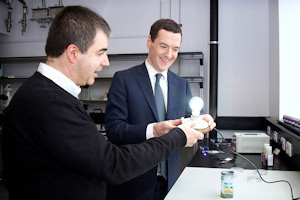Metaphors can be powerful in both good ways and bad. I once read that there was a ‘lighthouse’ metaphor used to explain a scientific concept to high school students which later caused problems for them when they were studying the biological sciences as university students. It seems there’s research now to back up the assertion about metaphors and their powers. From an Oct. 7, 2016 news item on phys.org,
Whether ideas are “like a light bulb” or come forth as “nurtured seeds,” how we describe discovery shapes people’s perceptions of both inventions and inventors. Notably, Kristen Elmore (Bronfenbrenner Center for Translational Research at Cornell University) and Myra Luna-Lucero (Teachers College, Columbia University) have shown that discovery metaphors influence our perceptions of the quality of an idea and of the ability of the idea’s creator. The research appears in the journal Social Psychological and Personality Science.
![While the metaphor that ideas appear “like light bulbs” is popular and appealing, new research shows that discovery metaphors influence our understanding of the scientific process and perceptions of the ability of inventors based on their gender. [downloaded from http://www.spsp.org/news-center/press-release/metaphors-bias-perception]](http://www.frogheart.ca/wp-content/uploads/2016/10/Metaphors_LightBulb.jpg)
While the metaphor that ideas appear “like light bulbs” is popular and appealing, new research shows that discovery metaphors influence our understanding of the scientific process and perceptions of the ability of inventors based on their gender. [downloaded from http://www.spsp.org/news-center/press-release/metaphors-bias-perception]
While those involved in research know there are many trials and errors and years of work before something is understood, discovered or invented, our use of words for inspiration may have an unintended and underappreciated effect of portraying good ideas as a sudden and exceptional occurrence.
In a series of experiments, Elmore and Luna-Lucero tested how people responded to ideas that were described as being “like a light bulb,” “nurtured like a seed,” or a neutral description.
According the authors, the “light bulb metaphor implies that ‘brilliant’ ideas result from sudden and spontaneous inspiration, bestowed upon a chosen few (geniuses) while the seed metaphor implies that ideas are nurtured over time, ‘cultivated’ by anyone willing to invest effort.”
The first study looked at how people reacted to a description of Alan Turing’s invention of a precursor to the modern computer. It turns out light bulbs are more remarkable than seeds.
“We found that an idea was seen as more exceptional when described as appearing like a light bulb rather than nurtured like a seed,” said Elmore.
But this pattern changed when they used these metaphors to describe a female inventor’s ideas. When using the “like a light bulb” and “nurtured seed” metaphors, the researchers found “women were judged as better idea creators than men when ideas were described as nurtured over time like seeds.”
The results suggest gender stereotypes play a role in how people perceived the inventors.
In the third study, the researchers presented participants with descriptions of the work of either a female (Hedy Lamarr) or a male (George Antheil) inventor, who together created the idea for spread-spectrum technology (a precursor to modern wireless communications). Indeed, the seed metaphor “increased perceptions that a female inventor was a genius, while the light bulb metaphor was more consistent with stereotypical views of male genius,” stated Elmore.
Elmore plans to expand upon their research on metaphors by examining the interactions of teachers and students in real world classroom settings.
“The ways that teachers and students talk about ideas may impact students’ beliefs about how good ideas are created and who is likely to have them,” said Elmore. “Having good ideas is relevant across subjects—whether students are creating a hypothesis in science or generating a thesis for their English paper—and language that stresses the role of effort rather than inspiration in creating ideas may have real benefits for students’ motivation.”
Here’s a link to and a citation for the paper,
Light Bulbs or Seeds? How Metaphors for Ideas Influence Judgments About Genius by Kristen C. Elmore and Myra Luna-Lucero. Social Psychological and Personality Science doi: 10.1177/1948550616667611 Published online before print October 7, 2016
This paper is behind a paywall.
While Elmore and Luna-Lucero are focused on a nuanced analysis of specific metaphors, Richard Holmes’s book, ‘The Age of Wonder: How the Romantic Generation Discovered the Beauty and Terror of Science’, notes that the ‘Eureka’ (light bulb) moment for scientific discovery and the notion of a ‘single great man’ (a singular genius) as the discoverer has its roots in romantic (Shelley, Keats, etc.) poetry.
